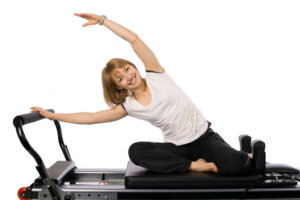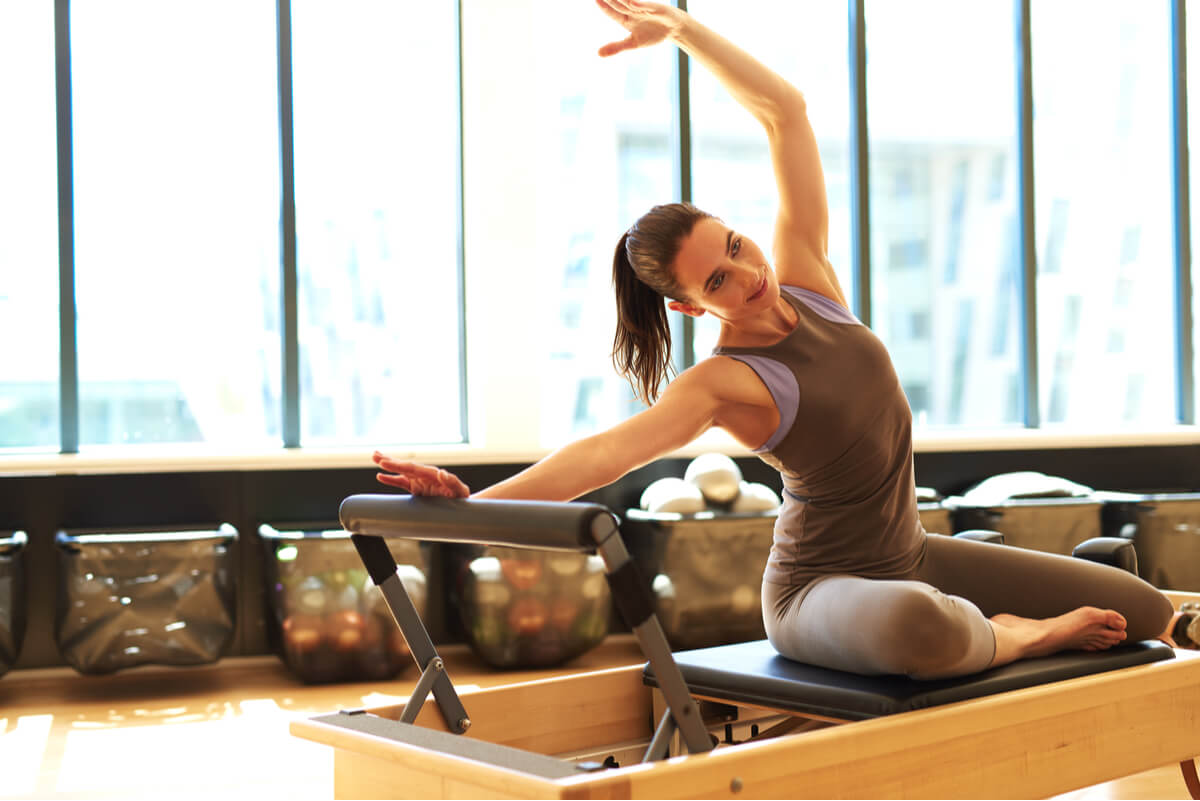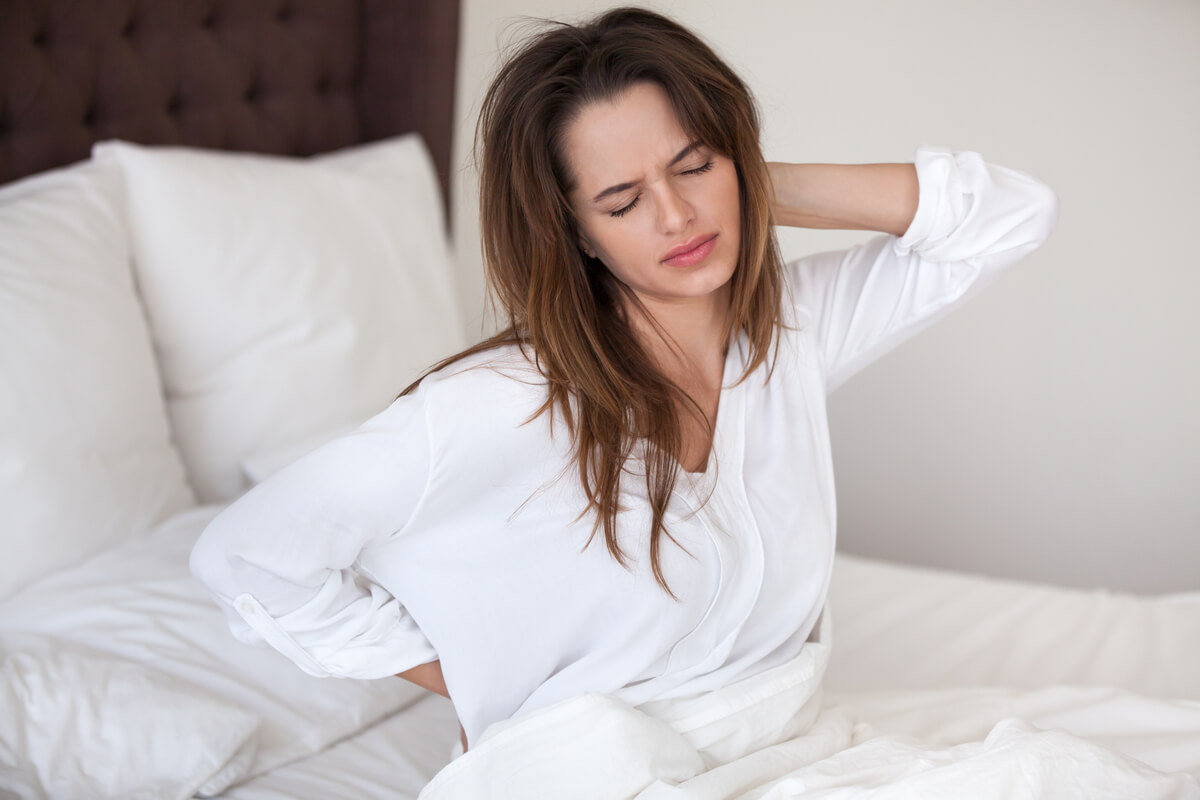The Benefits of Pilates for Fibromyalgia

Pilates is one of the most popular forms of exercise and has been around for decades. It’s frequently practiced by celebrities, athletes, and by people who simply want to stay active and fit. Its positive effects are remarkable, but what about the benefits of Pilates for fibromyalgia?
Fibromyalgia is a chronic disease in which general discomfort is the order of the day. Sometimes it seems to subside almost completely, and at other times it returns with great intensity. And, strangely, each time it seems to be different.
For this reason, it’s common for diagnosed patients to become discouraged, to tend to avoid exercise, and to believe that they can’t practice it because their condition could get worse.
However, exercise has been shown to be beneficial for fibromyalgia patients. It not only helps them improve their physical condition, where possible, but also contributes to their well-being. All this translates, in the medium and long term, into a higher quality of life.
Pilates basics

Pilates is a form of exercise that was created in the 20th century. Since then, it has become increasingly popular, given how easy it is to incorporate into almost anyone’s routine. It’s a form of exercise that allows you to get to know your body and, from there, to control it and gain greater well-being.
It takes gymnastics, yoga, and traumatology as a reference in order to provide a combination of exercises that focuses on working dynamism and muscle strength (especially of the internal muscles), but also conscious breathing and relaxation both of the body and of the mind.
What the research says about Pilates for fibromyalgia
Although there are few studies on the relationship between Pilates and exercise, the conclusions of research carried out in Brazil indicate that you can certainly appreciate the benefits of Pilates for fibromyalgia. It seems to be especially useful in reducing pain, improving functional capacity, and improving quality of sleep.
Exercise is an important part of fibromyalgia treatment, as it has been shown to significantly improve quality of life for patients.
Is Pilates recommended?

As indicated in many pieces of recent research, yoga, tai chi, and Pilates are recommended exercise routines for fibromyalgia patients. They can provide multiple benefits when combined with some aerobic activity.
Of course, this should always be within the framework of a personalized routine, which helps you achieve the objectives in a pleasant way. The idea isn’t to make any excessive physical effort that could trigger flare-ups.
If you suffer from fibromyalgia and want to start exercising to feel better, consult your doctor thoroughly about it. Together with them, you’ll be able to design an appropriate routine that’ll help you feel better – all at your own pace. You should start out gently and then adapt the routine to your new abilities.
In addition to this, once you’ve started to lead a more active lifestyle, you could follow the proposals of fibromyalgia associations and other similar groups. They’ll keep you informed and may provide sessions that allow you to alternate the routine at home with other places, such as a center or an outdoor park.
Remember that it’s important for exercise to be an enjoyable activity for you, one that will help you have fun, as well as taking care of yourself physically.
You don’t need to invest a large sum of money in top-of-the-range sports equipment, or join a specialized gym.
The most important thing is that you learn to design and follow a routine that benefits you on a daily basis. Practice it in a disciplined and consistent way, and adjust it to your needs little by little.
If you wake up feeling good, then go for it! But always do it wisely. And on days when you don’t feel quite so good, then stick to a gentler routine. Avoid a sedentary lifestyle, because this is your greatest enemy.
Pilates is one of the most popular forms of exercise and has been around for decades. It’s frequently practiced by celebrities, athletes, and by people who simply want to stay active and fit. Its positive effects are remarkable, but what about the benefits of Pilates for fibromyalgia?
Fibromyalgia is a chronic disease in which general discomfort is the order of the day. Sometimes it seems to subside almost completely, and at other times it returns with great intensity. And, strangely, each time it seems to be different.
For this reason, it’s common for diagnosed patients to become discouraged, to tend to avoid exercise, and to believe that they can’t practice it because their condition could get worse.
However, exercise has been shown to be beneficial for fibromyalgia patients. It not only helps them improve their physical condition, where possible, but also contributes to their well-being. All this translates, in the medium and long term, into a higher quality of life.
Pilates basics

Pilates is a form of exercise that was created in the 20th century. Since then, it has become increasingly popular, given how easy it is to incorporate into almost anyone’s routine. It’s a form of exercise that allows you to get to know your body and, from there, to control it and gain greater well-being.
It takes gymnastics, yoga, and traumatology as a reference in order to provide a combination of exercises that focuses on working dynamism and muscle strength (especially of the internal muscles), but also conscious breathing and relaxation both of the body and of the mind.
What the research says about Pilates for fibromyalgia
Although there are few studies on the relationship between Pilates and exercise, the conclusions of research carried out in Brazil indicate that you can certainly appreciate the benefits of Pilates for fibromyalgia. It seems to be especially useful in reducing pain, improving functional capacity, and improving quality of sleep.
Exercise is an important part of fibromyalgia treatment, as it has been shown to significantly improve quality of life for patients.
Is Pilates recommended?

As indicated in many pieces of recent research, yoga, tai chi, and Pilates are recommended exercise routines for fibromyalgia patients. They can provide multiple benefits when combined with some aerobic activity.
Of course, this should always be within the framework of a personalized routine, which helps you achieve the objectives in a pleasant way. The idea isn’t to make any excessive physical effort that could trigger flare-ups.
If you suffer from fibromyalgia and want to start exercising to feel better, consult your doctor thoroughly about it. Together with them, you’ll be able to design an appropriate routine that’ll help you feel better – all at your own pace. You should start out gently and then adapt the routine to your new abilities.
In addition to this, once you’ve started to lead a more active lifestyle, you could follow the proposals of fibromyalgia associations and other similar groups. They’ll keep you informed and may provide sessions that allow you to alternate the routine at home with other places, such as a center or an outdoor park.
Remember that it’s important for exercise to be an enjoyable activity for you, one that will help you have fun, as well as taking care of yourself physically.
You don’t need to invest a large sum of money in top-of-the-range sports equipment, or join a specialized gym.
The most important thing is that you learn to design and follow a routine that benefits you on a daily basis. Practice it in a disciplined and consistent way, and adjust it to your needs little by little.
If you wake up feeling good, then go for it! But always do it wisely. And on days when you don’t feel quite so good, then stick to a gentler routine. Avoid a sedentary lifestyle, because this is your greatest enemy.
-
Biundo, Joseph J. n.d. “Fibromialgia (Síndrome Del Dolor Miofascial).” In Manual MSD – Versión Para Profesionales. Accessed June 17, 2021. https://www.msdmanuals.com/es/professional/trastornos-de-los-tejidos-musculoesquelético-y-conectivo/afecciones-de-bolsas-sinoviales-músculos-y-tendones/fibromialgia.
- Busch AJ, Webber SC, Brachaniec M, Bidonde J, Bello-Haas VD, Danyliw AD, Overend TJ, Richards RS, Sawant A, Schachter CL. Exercise therapy for fibromyalgia. Curr Pain Headache Rep. 2011 Oct;15(5):358-67. doi: 10.1007/s11916-011-0214-2. PMID: 21725900; PMCID: PMC3165132.
-
“Fibromialgia.” n.d. American College of Rheumatology. Accessed June 17, 2021. https://www.rheumatology.org/I-Am-A/Patient-Caregiver/Enfermedades-y-Condiciones/Fibromialgia.
-
Flaño, Javiera. n.d. “Enfrentamiento y Tratamiento de Fibromialgia .” Escuela de Medicina – Facultad de Medicina. Accessed June 17, 2021. https://medicina.uc.cl/publicacion/enfrentamiento-tratamiento-fibromialgia/.
-
Kümpel, Claudia, Sônia Dias de Aguiar, Jéssica Paixão Carvalho, Daniela Andrade Teles, and Elias F. Porto. 2017. “Benefício Do Método Pilates Em Mulheres Com Fibromialgia.” ConScientiae Saúde 15 (3): 440–47. https://doi.org/10.5585/conssaude.v15n3.6515.
-
“La Guía Del Paciente Para El Síndrome de Fatiga Crónica & Fibromialgia.” n.d. ME/CFS & Fibromyalgia Self-Help. Accessed June 17, 2021. http://www.cfsselfhelp.org/library/Ejercicio,%20Nutrici%C3%B3n%20y%20Sensibilidad%20Qu%C3%ADmica.
-
Rivera, Jaime. n.d. “El Mejor Ejercicio Es El Que Se Hace. Diseña Tu Propio Ejercicio.” Fibromialgia Sin Miedos. Accessed June 17, 2021. https://www.fibromialgiasinmiedos.com/el-mejor-ejercicio-es-el-que-se-hace-disena-tu-propio-ejercicio/.
-
Sociedad Española de Reumatología. 2020. “Aprendiendo a Convivir Con La Fibromialgia Información Para El Paciente.” https://www.ser.es/wp-content/uploads/2020/11/Informacion-pacientes_FM_WEB.pdf.
Este texto se ofrece únicamente con propósitos informativos y no reemplaza la consulta con un profesional. Ante dudas, consulta a tu especialista.







